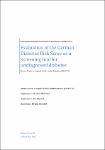Evaluation of the German Diabetes Risk Score as a screening tool for undiagnosed diabetes
Paprott, Rebecca
Background: Regional German studies estimated the prevalence of undiagnosed diabetes to be almost as high as the prevalence of diagnosed diabetes. Even before symptoms of diabetes occur, diabetes related secondary diseases can be developing and cause increased health care expenditures. The German Diabetes Association recommends the application of the German Diabetes Risk Score (German DRS) to screen for undiagnosed diabetes and thus enable early treatment of diabetic individuals. Methods: Data from the representative German National Health Interview and Examination Survey 1998 (N=7124), including a sample of the residential population aged 18-79 years, was used to compute the German DRS. Participants with prevalent diabetes or missing data were excluded from analyses (N=718). Correlation between score and biomarkers related to type 2 diabetes was assessed by Pearson’s correlation coefficients. Sensitivity, specificity, and the area under the receiver operating characteristic curve (AUC) were calculated for both undiagnosed diabetes (glycosylated haemoglobin (HbA1c) ≥6.5%; fasting plasma glucose (FPG) ≥126 mg/dl) and intermediate hyperglycaemia (HbA1c: 5.7-6.4%; FPG: 100-125 mg/dl). Results: Among the 6406 subjects, on average women had a lower score value than men. The German DRS was significantly negatively correlated with HDL-cholesterol among both genders while it was significantly positively correlated with glucose, HbA1c, triglycerides, total cholesterol, γ-glutamyltransferase, and alanintransferase. Sensitivity and specificity for undiagnosed diabetes at a cut point of ≥500 was 93.9/50.4 using FPG and 91.2/56.6 using HbA1c as diagnostic criterion. For intermediate hyperglycaemia it was 70.9/63.0 applying FPG and 67.3/67.2 applying HbA1c for diagnosis. The estimated AUC for undiagnosed diabetes was 0.79 using FPG and 0.84 using HbA1c. AUC values for intermediate hyperglycaemia were 0.72 applying FPG and 0.74 using HbA1c. Conclusion: Compared to two other German study populations, the German DRS yielded similar discriminatory ability for undiagnosed diabetes among an 18-79 years old German survey population. Further research with regard to identification of high risk groups for diabetes and to differences in performance of the German DRS between both genders and different age-groups would be useful to improve efficiency of the German DRS as a screening tool for undiagnosed diabetes.
Files in this item
No license information

